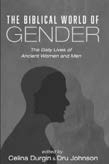The Biblical World Of Gender: The Daily Lives Of Ancient Women And Men -- By: Joshua M. Greever
Journal: Eikon
Volume: EIKON 04:2 (Fall 2022)
Article: The Biblical World Of Gender: The Daily Lives Of Ancient Women And Men
Author: Joshua M. Greever
Eikon 4.2 (Fall 2022) p. 122
The Biblical World Of Gender: The Daily Lives Of Ancient Women And Men
REVIEWED BY
Joshua M. Greever is Professor of New Testament at Bethlehem College and Seminary, Minneapolis, MN.

Celina Durgin and Dru Johnson, eds. The Biblical World of Gender: The Daily Lives of Ancient Women and Men. Eugene, OR: Wipf and Stock, 2022.
Introduction
The Biblical World of Gender, edited by Celina Durgin and Dru Johnson, is a collection of essays of various lengths that analyze the Bible’s portrait of men and women. The thirteen essays are organized into four sections: gender roles in the ancient world (Section 1), positive examples of biblical figures (Section 2), negative examples of biblical figures (Section 3), and misunderstood texts concerning gender (Section 4). Most of the essays are no more than ten pages in length, making The Biblical World of Gender accessible and brief.
Summary
Section 1 includes four essays. Carol Meyers suggests that archaeological evidence shows that ancient Israelite
Eikon 4.2 (Fall 2022) p. 123
culture was not as patriarchal as sometimes is supposed, since women had much responsibility and influence within the household. Cynthia Shafer-Elliott stresses that the ancient Israelite household was a heterarchy — as opposed to a patriarchal or egalitarian model — in which power, authority, and responsibility were fluid and shared. Jeffrey Garcia contends that archaeological and inscriptional evidence points to the activity of women in synagogue services; they sat with the men, sometimes read the Torah, and perhaps even were the heads of the synagogue. Finally, Lynn Cohick contends that women in the Roman world had a certain amount of agency, for they could hold a high social status and were not restricted from making public appearances or from speaking in public.
Section 2 collects essays highlighting some of the commendable men and women in the Bible. Carmen Joy Imes writes on the women involved in the deliverance of Moses as an infant. James McGrath highlights the crucial role Jesus’s female disciples played in Jesus’s own ministry. Beth Stovell shows that some of the commendable men in the Bible, such as Joseph, Jonathan, Boaz, Jesus, the Beloved Disciple, and Paul, exemplify the virtues of forgiveness, friendship, and care for family and the helpless.
Section 3 highlights some less commendable examples of men and women in the Bible. Matthew Lynch argues that Genesis 1–11 portrays equality between males and females as the ideal, and male domination — exemplified in the case of Lamec...
Click here to subscribe
